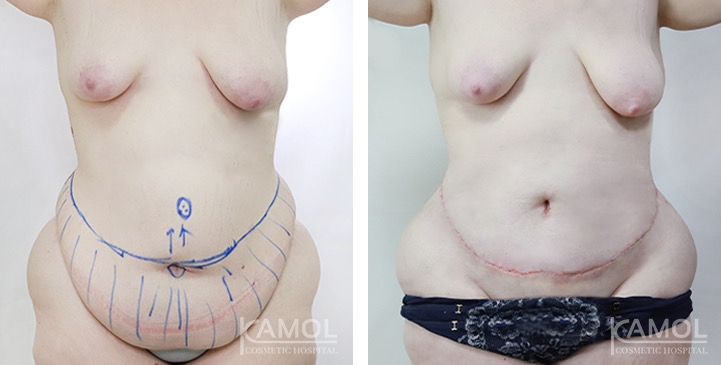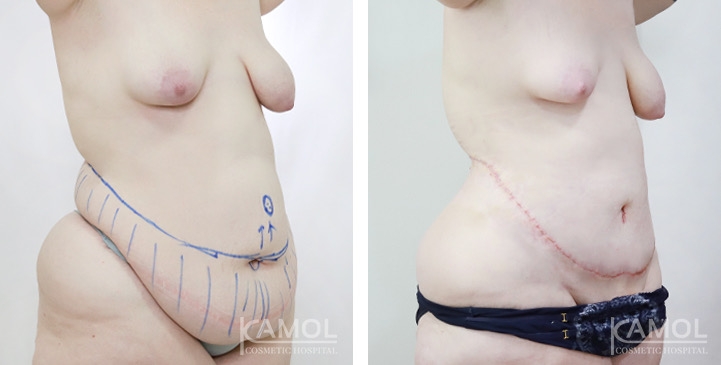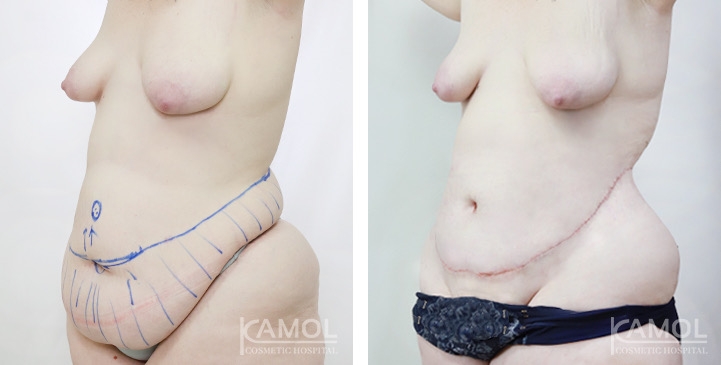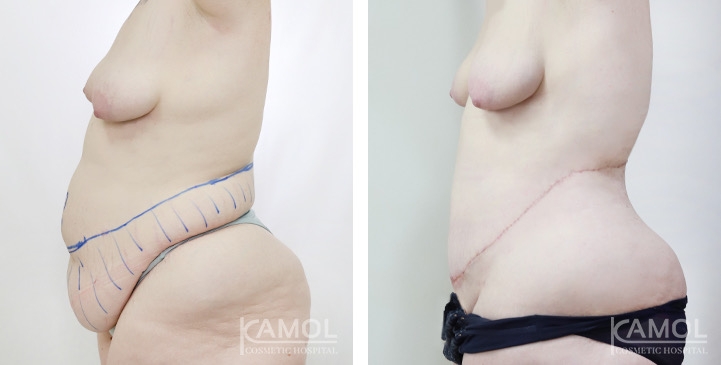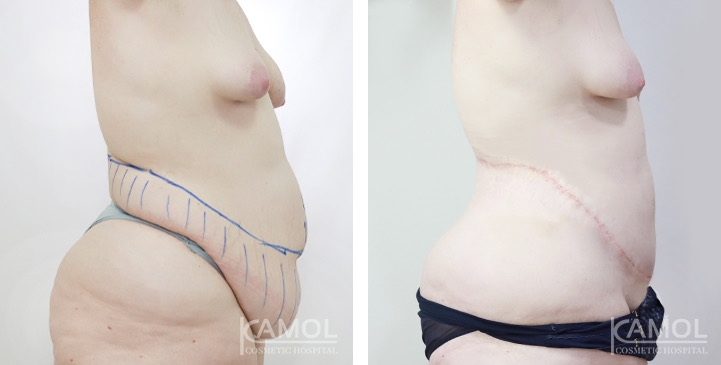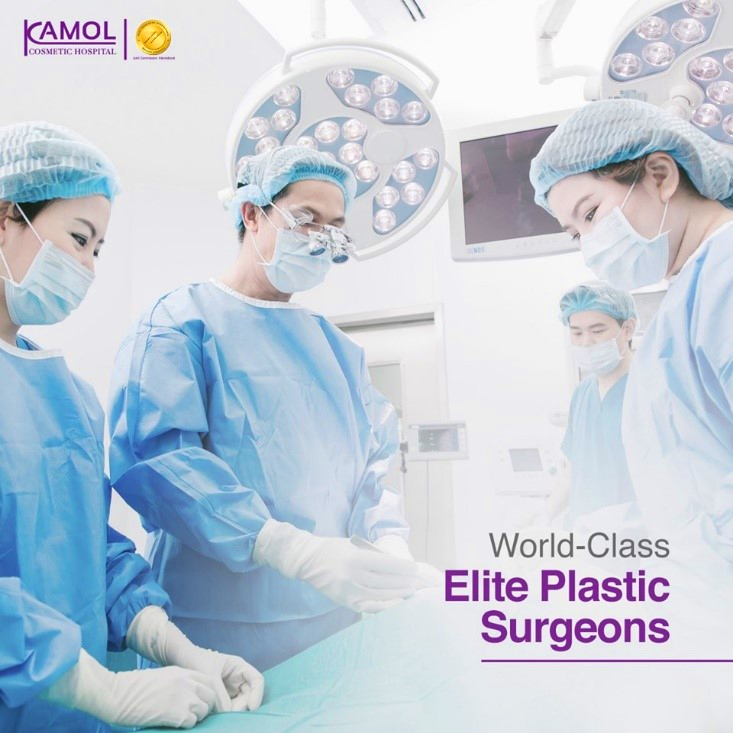Abdominoplasty / Tummy Tuck in Bangkok, Thailand
Abdominoplasty, or tummy tuck, is a procedure that flattens the abdomen by removing extra fat and skin and tightening muscles in your abdominal wall. The procedure benefits those after childbirth, especially women after numerous pregnancies, and helps them get desirable body figures. With an incision along the bikini line, the surgery is performed under general anesthesia, and it takes around 3-4 hours. After the surgery, the patient must be admitted to the hospital for three nights. The surgery usually leaves a scar along the pubic hairline, possibly from the left to right side of the hips, depending on the volume of fat and excess skin.
We offer two types of Abdominoplasty / Tummy Tuck
1. Abdominoplasty / Tummy Tuck with umbilical transposition and repairing the sagging abdominal muscles
This procedure is suitable for a person with a lot of excess fat and skin or stretch marks from childbirth. This procedure must be performed under general anesthesia.
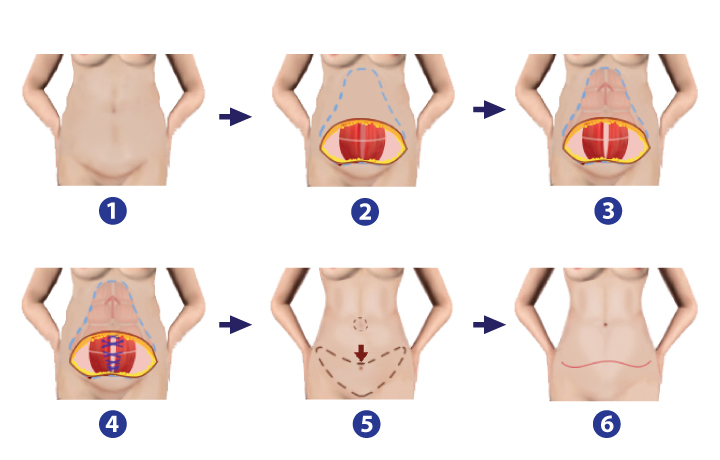
Picture 1. Shows the procedure of Abdominoplasty /tummy tuck with umbilical transposition and repairing the sagging abdominal muscles
1. The surgeon will examine the muscles' sagging for surgical planning, as shown in Figure 1.
2. The surgeon marks the incision on the bikini line and then opens the wound through the layer of the skin to the muscle, as shown in Figure 2.
3. Fibrosis between the layer of the skin and the muscle is released from the pubic to the sub-mammary area. The surgeon will then see the sagging muscles.
4. The surgeon then repairs the sagging abdominal muscles from the sub-mammary to the pubic, tightening the abdominal muscles, as shown in Figure 4.
5. The skin and fat layer is pulled down, with the excess from the former umbilical to the pubic removed. The surgeon then sutures the fat layer with the dissolvable stitches and carefully creates and retouches the new umbilical to prevent the scar, as shown in Figure 5.
6. The surgeon cuts and sutures the excess skin on the pubic area.
**The operation time is around 3-4 hours**
2. Mini Abdominal Lipectomy
This procedure is suitable for a person who has moderate excess fat but with stretch marks. This procedure aims to correct the stretch marks and can be performed under local or general anesthesia. The patient can perform by-day surgery.

Picture 2. Shows Surgical Procedures of Mini Abdominoplasty.
1. The surgeon will check the sagging of the muscles for surgical planning, as shown in Figure 1.
2. The surgeon opens the wound on the pubic and releases the fibrosis between the skin layer and the muscle from the pubic to the below umbilical area.
3. The layer of the skin and fat is then pulled down. The surgeon then cuts and sutures the excess
skin on the pubic area.
Preparing for Abdominoplasty / Tummy tuck
- Consult with the surgeon about your goals, lab test, and medical evaluation
- Get a lab test or a medical evaluation
- Take certain medications or adjust your current medication
- Stop smoking before and after surgery 2 weeks
- Avoid taking aspirin, anti-inflammatory drugs, and herbal supplements as they can increase bleeding
Procedure for Abdominoplasty / Tummy Tuck
- Step for Anesthesia: we offer general anesthesia.
- The surgeon marks the area for an incision at the bikini line and then opens the incision; if the patient requires the Tummy tuck to reposition the umbilical and repair the sagging muscle, the patient has to open the tissue above the abdominal muscle pass through the lower breast (submammary area), and then fix the muscle to tighten at the midline of the abdomen. Pull down the skin and cut the excess. If patients require a mini tummy tuck, the surgeon will open the incision and cut the excess skin.
- Close the incision by suture
Post-operative Care for Tummy Tuck
- During the first 2-3 days after the surgery, the patient must wear the full-length compression garment daily to tighten the muscle and reduce swelling. After one month, the patient can continue to wear it at night to support the muscle.
- The stitches will be removed six days after the surgery.
- The patient can start exercising about two months after the surgery.
- The swelling will reduce, and the wound will be healed three to four months after the surgery.
Forewarning for Post-operative Care
- Refrain from showering until two to three days after the surgery. Dress the wound according to the doctor’s recommendation.
- Wear the compression garment all the time during the first month. After one month, the patient should continue wearing it to support the muscle and prevent the wound from tearing.
- Bruises might be visible but should be gone in two to three weeks. If there is pain, swelling, or redness, please come to see the doctor immediately.
Risks and Complications for Tummy Tuck
- Bleeding
- Infection
- Fluid accumulation (seroma)
- Poor wound healing
- Skin loss
- Numbness
- Skin discoloration and prolonged swelling
- Scarring
- Anesthesia risks
- Recurrent looseness of skin
- Fat necrosis
- Deep vein thrombosis, cardiac and pulmonary complications
- Asymmetry
- Persistent pain
Recovery from Tummy Tuck
The recovery of Abdominoplasty / Tummy tuck varies depending on the surgical technique performed. Your drains will be left in for a few days after the surgery. You must take an antibiotic and an anticoagulant while your drains are in place. You need to wear an abdominal binder for about six weeks. It will help you avoid fluid buildup and support your abdomen. Mini Abdominoplasty / Mini tummy tuck usually uses a shorter period of recovery. You need to avoid strenuous activity for at least six weeks and can return to work after surgery for 2-6 weeks.
Getting to Know for Abdominoplasty / Tummy Tuck
How to prevent and treatment scar after tummy tuck?
In this article, we will discuss ways to prevent tummy tuck scars and how to treat them if they occur.
Mommy Makeover
A mommy makeover is a customized combination of cosmetic procedures designed to help...
Mini Tummy Tuck vs Full Tummy Tuck
We will explore the key differences between the two to help you make an informed decision about which is...
Before & After for Tummy Tuck
Reviews for Tummy Tuck
How long does it take for Tummy Tuck scars to go away?
The recovery time for a tummy tuck can vary depending on the individual and the extent of the surgery. Typically, the initial healing process can take several weeks. Generally, it can take several months for the incision lines to fully heal and for the scars to fade. However, the final appearance of the wounds can take up to a year or more. Additionally, after the surgery, it's important to follow the care instructions provided by your surgeon to ensure proper healing and to minimize the visibility of scars.
What are the steps to follow to treat Tummy Tuck scars?
The best way to treat tummy tuck scars is to follow the care instructions provided by your surgeon. Here are a few general steps that may be recommended:
- Keep the incision clean and dry: Your surgeon will give instructions on how to care for it, which may involve cleaning it with an antiseptic solution and keeping it covered with a bandage for the first few days.
- Avoid strenuous activities: You'll need to avoid strenuous activities that can cause strain on the abdominal area, such as heavy lifting or intense exercise, for several weeks after surgery.
- Wear compression garments: Your surgeon may recommend wearing a compression garment or elastic bandage to help support the abdominal area and reduce swelling.
- Massage the scars: After the incision has healed, your surgeon may recommend that you massage the wounds to help soften and flatten them.
- Avoid sun exposure: It is important to protect scars from the sun to prevent darkening or hyperpigmentation
- Use topical treatments: Your surgeon may recommend using topical treatments such as silicone gel or scar cream to help improve the appearance of the scars.
It's important to note that scarring is a natural part of the healing process, and not all scars can be completely eliminated. However, following these steps can help minimize the scars' visibility and promote healing.
How can Tummy Tuck scars be prevented, and how can they be controlled?
While it is impossible to completely prevent scars from forming after a tummy tuck, you can take steps to minimize their appearance and help them heal well.
- Choose a qualified surgeon: Selecting a skilled and experienced plastic surgeon can help minimize the risk of complications and ensure that the incision is made in a way that minimizes scarring.
- Follow post-operative instructions: Following your surgeon's post-operative instructions carefully, such as keeping the incision clean and dry, avoiding strenuous activities, and wearing compression garments as advised, can help to minimize the risk of complications and promote healing.
- Avoid sun exposure: It is important to protect the scars from the sun to prevent darkening or hyperpigmentation.
- Massage the scars: After the incision has healed, your surgeon may recommend that you massage the wounds to help soften and flatten them.
- Use topical treatments: Your surgeon may recommend using topical treatments such as silicone gel or scar cream to help improve the appearance of the scars.
Frequently Asked Questions
A: A tummy tuck, also commonly referred to as abdominoplasty, is a cosmetic surgical procedure designed to flatten the abdomen and create a smoother, firmer contour. It achieves this by removing excess skin and fat from the abdomen and tightening the underlying abdominal muscles.
abdominoplasty is a popular option for individuals who have experienced significant weight loss, pregnancy, or aging, which can leave them with an excess of loose skin, stretch marks, and weakened abdominal muscles.
A: Abdominoplasty offers numerous noteworthy benefits, including:
- Flatter abdomen: Achieve a smoother, more toned abdominal profile.
- Improved body contour: Create a more proportionate and balanced figure.
- Removal of excess skin: Eliminate any loose, sagging skin that is resistant to diet and exercise.
- Tightened abdominal muscles: Strengthen weakened abdominal muscles for improved core strength and posture.
- Reduced stretch marks: Minimize the appearance of stretch marks in the lower abdomen area.
- Enhanced self-confidence: Feel more comfortable and confident in your physical appearance.
A: If the following apply to you, then you may be a solid candidate for surgery:
- You are in relatively good overall health.
- A non-smoker.
- Currently maintaining a stable weight
- You have realistic expectations about the outcome of the procedure.
- You have significant excess skin or laxity in the abdominal area.
We would strongly advise that you schedule a consultation with a qualified plastic surgeon before making any final decisions. Our team at Kamol Cosmetic Hospital will assess your individual needs, discuss your cosmetic goals, and decide if the procedure is the safest and most appropriate option for you.
A: There are several types of abdominal plastic surgery to choose from, including:
- Full tummy tuck: This is the most comprehensive procedure, involving an incision across the lower abdomen and around the navel. It addresses excess skin and fat in the entire abdominal area.
- Mini tummy tuck: This involves a smaller incision and is suitable for individuals with less excess skin and fat, primarily located below the navel.
- Extended tummy tuck: This extends beyond the traditional procedure, addressing excess skin and fat in the hips and flanks (aka “love handles”) as well.
A: First of all, the procedure is typically performed under general anesthesia. During the procedure, the surgeon will then:
- Make the necessary incisions based on the type of operation you have opted for.
- Remove excess skin and fat from the abdomen area.
- Tighten the underlying abdominal muscles.
- Reposition the navel (if necessary).
- Close the incisions with sutures or surgical tape.
- The whole procedure usually takes several hours to complete.
A: After abdominal plastic surgery, you can expect the following during your recovery:
- Swelling and bruising: This is normal and will gradually subside by itself over time.
- Drains: Small tubes may be placed under the skin to drain any excess fluid.
- Compression garment: You'll be required to wear a compression garment to minimize any swelling and support the abdomen during its crucial healing.
- Pain medication: You may be prescribed certain pain medications to help manage any discomfort.
- Limited activity: You must avoid any strenuous activities and heavy lifting for several weeks.
- Follow-up appointments: You'll have regular follow-up appointments with your surgeon to monitor your overall healing progress.
A: As the procedure does involve incisions, you can expect there to be some scarring. However, our skilled surgeons use the most advanced techniques to help minimize any scarring. We also place incisions as low as possible on the abdomen, often within the bikini or belt line.
In any case, over time, the scars will fade and become less noticeable.
A: You may indeed experience some discomfort and soreness after the surgery, however, this will be easily managed with pain medication. As for the procedure itself, you will be under anesthesia.
A: The results of the procedure tend to be long-lasting, especially if you are able to maintain a stable weight and healthy lifestyle.
However, please be aware that natural aging and future pregnancies are likely to affect the results over time – so you must be realistic about the outcome.
A: While it is indeed possible to get pregnant after the procedure, we generally like to recommend that our female patients wait until they have built a family before considering the surgery.
The reality is, that pregnancy can stretch the abdominal muscles and skin all over again, thus potentially negatively affecting the results of your operation.
A: In some cases, insurance may cover the procedure if it's deemed medically necessary, such as to repair abdominal muscles separated during pregnancy (diastasis recti). We recommend consulting with your medical health insuranve provider to be sure.
A: Kamol Cosmetic Hospital is an industry-leading provider of many types of aesthetic surgery in Bangkok, Thailand. You can enjoy:
- Highly experienced surgeons: Our surgeons are world-class experts in body contouring techniques and have a proven track record of countless successful cosmetic procedures.
- State-of-the-art facilities: Our hospital is equipped with the latest and most advanced technology. We pride ourselves in providing our patients with a safe and comfortable environment.
- Personalized care: Each treatment plan is tailored to your individual needs and aesthetic goals.
- Comprehensive aftercare: You will receive thorough post-operative care and support to ensure a smooth and successful recovery.
- Winning reputation: Kamol Cosmetic Hospital is committed to patient satisfaction and delivering beautiful results.
A: Abdominoplasty in Thailand can vary significantly in price, depending on which hospital you choose, who your surgeon is, the type of surgery performed, the complexity of the procedure, and any additional procedures performed alongside it.
Kamol Cosmetic Hospital will provide you with a detailed quote before you make any final commitments.
A: If you’d like to go ahead and arrange a consultation with one of our expert surgeons, you can contact us through our website, via email, or by phone.





